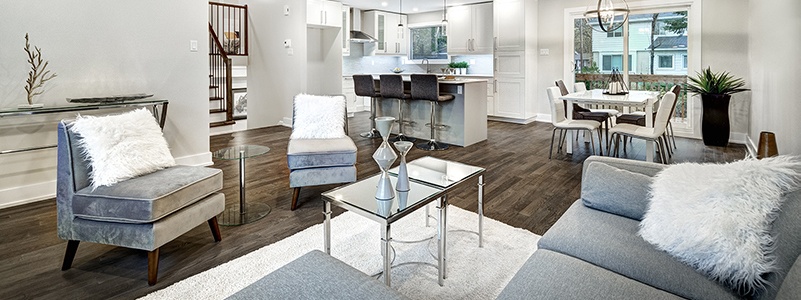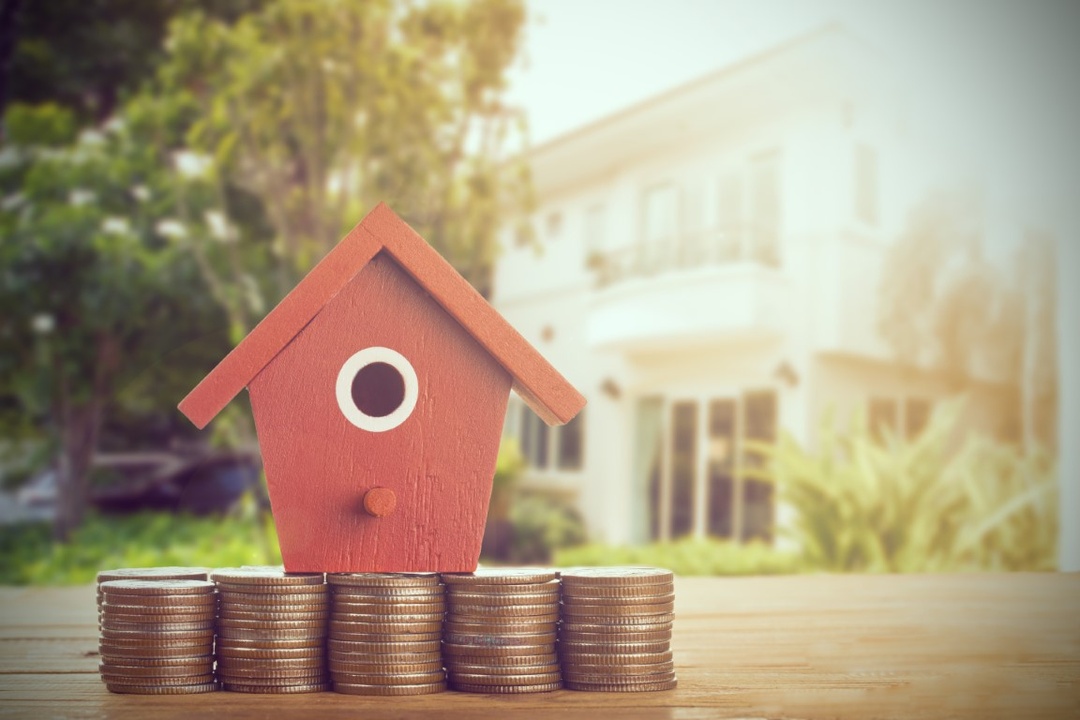
Picture this: you walk into a brightly lit home with clean furniture laid out in a way that maximizes the space. You imagine yourself waking up to natural light, brewing a pot of coffee in a pristine kitchen, and relaxing on the porch in plush patio furniture.
Now, imagine that you walk into the same home, but it’s crowded with furniture, dusty knickknacks, and grimy carpet. What scenario would you rather your potential buyers experience? Staging your home means the difference between the two.
While it is often seen as unnecessary and expensive, staging a home doesn’t have to cost a lot of money, and you’ll most likely get a return on your investment. The NAR states that 71% of sellers’ agents believe a well-staged environment increases the dollar value buyers are willing to offer, yet the median cost of staging is only $1500.
A few quick and budget-friendly changes can go a long way, according to staging professionals, including a fresh coat of paint, general decluttering, changing rugs, and plugging in an oil diffuser to ensure a pleasant smell.

1. Ask Your Realtor
When you first list your home with a Realtor, they will do a walkthrough of the property and offer practical suggestions on how to prepare your home to sell. Though some suggestions may seem inconsequential or be hard to hear because of emotional attachments to your things, remember that they are spoken from years of experience and with your best interests in mind. Listening to your Realtor’s advice is a great way to set yourself on a path to success.
2. Decide on a Budget
Whether you plan on hiring a professional home stager or doing the work yourself, it’s important to decide how much to spend before you begin. Sit down with your Realtor and discuss what needs to be done and what a reasonable budget would be. It’s important to take into consideration both what you have to spend as well as how much it will increase the price of the home to ensure you don’t overspend costs you can’t recoup.

3. Pretend You’re in a Stranger’s House
Before you begin with the staging process, it can be helpful to walk through your home as if it belonged to someone else. Start out in the front yard and make notes as you walk through.
Look for anything that would draw the eye of a potential buyer such as smudges on walls, chipped paint, cluttered counters, or dirty baseboards. This can help you draft a to-do list for your staging project.
4. Start with a Good Scrub
One of the easiest ways to show off your home is to scrub away the lived-in grime that naturally accumulates in every home. NAR’s 2019 Profile of Home Staging states that 89% of Realtors recommend a deep clean to all of their sellers. Make sure everything, from ceiling to floor, gets a thorough cleaning. Be sure to get into often neglected areas, such as baseboards, behind always-open doors, windowsills, and closet floors.

5. Reduce the Clutter
Unless you are a minimalist, you probably have cluttered areas in your home, whether that is the kitchen counter where everyone dumps their stuff or the treasured collection of beloved knickknacks.
Visual clutter makes a home seem small and crowded, preventing potential owners from visualizing their own life there. Reduce clutter by purging items ahead of your move, or just packing them away to treasure in your next home.
6. Remove Personal Touches
According to NAR, 83% of homebuyers credited staging for their ability to visualize the space as their future home. Part of the staging process includes the critical step of depersonalizing. Depersonalizing a space includes taking down personal photos, artwork that isn’t necessarily appealing to most, and anything that announces your own personal, political, or religious taste.

7. Make Any Repairs You Can
It can be easy to live with little repairs that need to be made, but those can cost you when selling your home. Knock out all the items on your “honey-do” list to keep little issues from becoming a big stumbling block for buyers. Whether that means oiling squeaky doors, fixing a dripping faucet, or replacing a cracked socket plate, it will be time well spent.
8. A Little Paint Goes a Long Way
You may adore the bold accent wall you painted in your dining room, but the color may be off-putting to a potential buyer with a more neutral palate. Additionally, chipped, dingy or outdated color on the walls can make your home seem dated and run down.
A fresh coat of paint in a neutral color is a great way to brighten a space and make it seem fresh and clean. This relatively inexpensive step will go a long way.

9. Don’t Forget the Floors
A dirty floor can ruin the impact of an otherwise visually stunning room. Stained or discolored carpet, in particular, can hold odors and allergens and make the whole house seem dirty.
Whether you hire professional carpet cleaners or do it yourself, make sure you give all carpets a deep clean. Hard surface floors should also be scrubbed, refinished or polished to restore them to their original shine. If you have tile, don’t forget to scrub the grout as well.
10. Clear Out the Closets to Accent Space
Don’t forget to stage the hidden areas as well. Closets that are jam-packed with clothes will look small and give the impression that there isn’t enough storage in the home. Pack up out of season items and take a moment to purge clothing and accessories you no longer want. Be sure to vacuum the floors and shelves in the closets and toss in an air freshener to banish stale smells.

11. Keep It Bright and Open
Bright natural light will make even the smallest spaces seem more open and inviting. Open curtains and blinds and clean all of your windows to a sparkling shine to create an airy atmosphere.
For evening showings, make sure the bulbs in all your light fixtures work and add lamps or other accent lighting to darker rooms to brighten them up. Don’t forget to check the lights in hallways and closets as well.
12. Curb Appeal Counts
One of the most critical elements of home staging is the outside of your home. Just as on a blind date, first impressions will make or break a showing.
If your home and yard look neat and inviting, potential buyers will walk in with a strong positive feeling in place. Power wash the exterior of your home and driveway, touch up paint, mow and weed, and plant cheerful flowers to make your home a favorite before they even walk in the door.

13. Make the Kitchen Sparkle
The kitchen is another area where it’s critical to make the best impression. A few simple changes can go a long way in this utilitarian space. Clean off counters to showcase space as a cluttered kitchen gives the impression that there isn’t enough storage.
Wipe down cabinet fronts and replace dated hardware, such as cabinet handles and hinges, for an instant facelift. If it’s in your budget, update light fixtures or faucets and repaint or stain cabinet fronts.
14. Make the Living Room Cozy
While we’ve advised you to depersonalize, it’s important not to leave your home feeling cold, particularly in the living room. This room should exude warmth and a cozy atmosphere so potential buyers can see themselves relaxing there. Rearrange furniture to make sure that the layout is conducive to conversations and flows easily into other rooms.
If the living room is crowded, consider removing some of the furniture to open it up and make it appear larger. Reduce clutter but leave one or two groupings of decorative items. A few bright throw pillows and a lamp will also add warmth and personality back into the room.

15. Don’t Hide Your Amenities
While you may never use the brick fireplace in your living room or the French doors to your patio, these features are selling points for your home. Make sure your selling features aren’t blocked by furniture or decorative items and show them off to their best advantage.
16. Set the Stage in Specialized Spaces
Specialized rooms, such as dining rooms or offices, benefit from staging to showcase their intended purpose. Remove unrelated items, such as craft supplies or games, from your dining room and set the table to help potential buyers visualize
Thanksgiving dinner there. In an office space, make sure it’s clean and clutter-free with a defined work station. Visualize what potential buyers will want to use each space for and stage it to match that expectation.

17. Focus on Serenity in the Master
Of the Realtors polled in NAR’s 2019 Profile of Home Staging, 78% stated they regularly staged the master bedroom when selling a home. The master bedroom is a home owner’s ultimate retreat from the stress of the world.
In addition to the decluttering and deep cleaning done throughout the home, wash all linens to bring freshness and banish musty smells - don’t forget throw pillows and blankets. Additionally, remove items that don’t belong, such as kids’ toys in the bathtub.
Open the windows to let in natural light and make sure you have lamps to provide soothing evening light. Candles and a potted plant or two can also add to the serene atmosphere.
18. Style the Backyard
More and more people are seeing the backyard as a space for entertaining and relaxing, so it’s important to style it as such. Wash any outdoor furniture, grills, and fire pits and give your deck or patio a power wash.
Mow and weed the lawn, trim up the landscaping and plant fresh flowers. Make sure all toys and pet messes are cleaned up daily to keep the space inviting. If you don’t have anything in your backyard, consider getting a small patio table or bench for an outdoor seating area.

19. Think About Symmetry and Flow
When styling any room in your home, consider which furniture arrangement will give you the most open walkable space. You should also look for ways to promote symmetry. A large dark armoire at one end of the room could draw the eye and distract from the beautiful bay window.
If you have a lot of large or mismatched pieces, consider putting some of it in storage to open up walkways and provide better visual symmetry. The idea is to open your spaces up so potential buyers can visualize their own furniture there.
20. Corral the Toys
Whether your babies are of the two or four-legged variety, toys have a tendency to take over the entire house. Consider paring the number of toys down, packing the rest away for later or rotating them out weekly basis to make them easier to maintain. Toys not kept in a child’s room should be hidden away in a lidded box or basket to avoid distracting from the staging of that room.

21. Follow the 60-30-10 Rule
If you are staging your home yourself, you can achieve a welcoming color palate by using the 60-30-10 color rule. Basically, 60% of the room should be made up of a dominant neutral color, 30% should be a secondary color, and 10% should be an accent color.
Textures and patterns can also be brought in for the 30% and 10% to add more variety to the space. This go-to decorator’s rule will allow for interest in your color scheme without overwhelming the space.
22. Group Decorative Items to Tell a Story
Bringing in a few specific decorative pieces and styling them in groups of three can help bring personality to a room without adding clutter. A grouping can include three items in different shades of the same color, three items that fit together on a theme, or a matching set of 3.
Potted plants, books, candles, vases, and knickknacks will all look better in groups of three. Just be sure not to overdo it, too many groups of 3 will bring back the clutter you worked so hard to eradicate.

23. Make It Smell Welcoming
No matter how much work you put into cleaning and arranging your home, it can all be undone by unwelcome odors. Pet smells, cooking odors, and general musty smells from fabrics can create an immediate bad impression with potential buyers.
Open up windows to air out your home and make sure you wash all window treatments and rugs. Use candles, plug-ins, or oil diffusers to spread an inviting scent through your home, but be sure to stick to 1-2 unobtrusive and complimenting scents to avoid scent overload. A fresh linen, pine, citrus, or vanilla scent will make your space warm and inviting.
24. Keep It Clean
Once you’ve deep cleaned your home to a brilliant shine, it’s important to keep it that way until your home sells. While it can be daunting to keep your home in pristine condition, particularly if you have small children, it will be much easier than cleaning in a panic when you get notified of a showing request. Create a daily cleaning regimen that you can manage to keep the upkeep to a minimum.

25. Consider a Professional Home Stager
While there are many ways to stage your home yourself, or with the advice of your Realtor, the process can simply feel too overwhelming or time-consuming. A professional home stager will bring experience and expertise, as well as resources to help you stage your home to its best advantage. Fixr.com reports that a homeowner will pay $1,500 on average to have their home professionally staged.
The NAR found that 22% of sellers’ agents found that staging a home increases the dollar value offered by buyers by one to five percent. Similarly, 17% found that it increases the value by six to ten percent.
This means that staging a $250,000 home can increase the buying price by up to $25,000. When you consider the possible gains, the cost of a professional stager makes more sense.
26. Why Staging a House Is So Important
Staging your home is setting the stage for a successful sale. Staging helps potential buyers imagine themselves living in a home. A 2015 survey from the National Association of Realtors found that over 81% of buyers “find it easier to visualize the property as their future home,” when it is staged.
As mentioned before, staging your home can also potentially increase the price your home sells for by up to 10%. In a study done by Staged4More School of Home Staging, 88% of their staged homes sold for over asking price in 2019.
On top of getting top dollar for your home, staging will also help increase the speed of the sale. A 2015 Real Estate Staging Association survey found that professionally staged homes spend 72% less time on the market compared with non-staged homes.
When all is said and done, staging is an extremely beneficial tool when selling your home. From increasing the buying price of a home and decreasing time on market, to helping fuel potential buyers’ emotional response to a home; staging matters a great deal and shouldn’t be overlooked.










